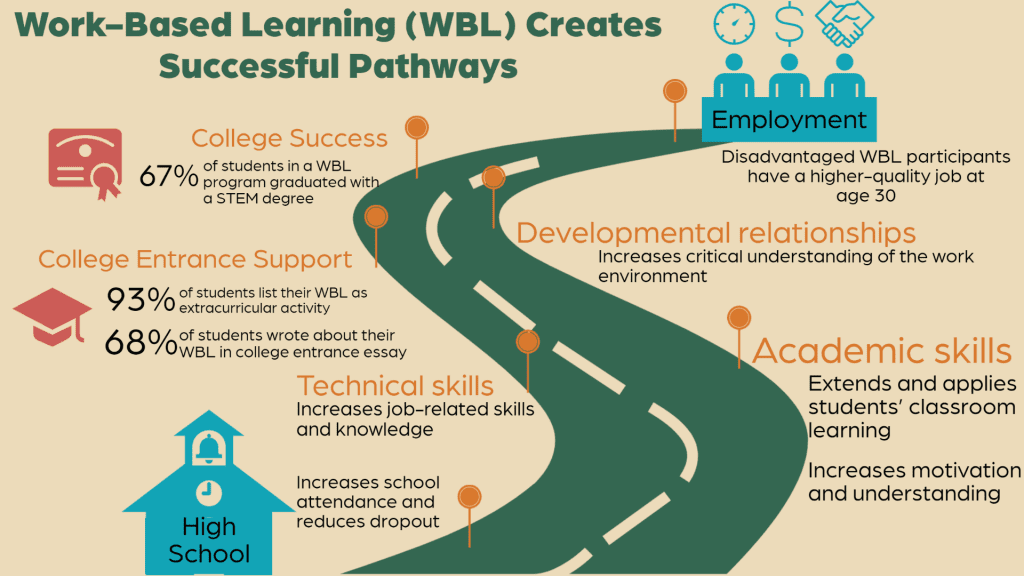We are continually developing multimedia resources for Work-Based Learning. Please check back often for more resources. If you have suggestions for what type of resources you would like us to create, please fill out this CONTACT US form.

Title: “Work-Based Learning (WBL) Creates Successful Pathways“
File Format: PNG File
File Size: 508 KB
To download the image please fill out your name and email address and click "download"

Title: “Colorado’s Work-based Learning Continuum”
File Format: PDF File
File Size: 129 KB
To download the image please fill out your name and email address and click "download"
Literature Used in Multimedia Resources
Rohrbaugh, Margaret C., and Victor G. Corces. “Opening pathways for underrepresented high school students to biomedical research careers: The Emory University RISE program.” Genetics 189.4 (2011): 1135-1143.
Abstract: Increasing the college graduation rates of underrepresented minority students in science disciplines is essential to attain a diverse workforce for the 21st century. The Research Internship and Science Education (RISE) program attempt to motivate and prepare students from the Atlanta Public School system, where underrepresented minority (URM) students comprise a majority of the population, for biomedical science careers by offering the opportunity to participate in an original research project. Students work in a research laboratory from the summer of their sophomore year until graduation, mentored by undergraduate and graduate students and postdoctoral fellows (postdocs). In addition, they receive instruction in college-level biology, scholastic assessment test (SAT) preparation classes, and help with the college application process. During the last 4 yr, RISE students have succeeded in the identification and characterization of a series of proteins involved in the regulation of nuclear organization and transcription. All but 1 of 39 RISE students have continued on to 4-year college undergraduate studies and 61% of those students are currently enrolled in science-related majors. These results suggest that the use of research-based experiences at the high school level may contribute to the increased recruitment of underrepresented students into science-related careers.
Salto, Lorena M., et al. “Underrepresented minority high school and college students report STEM-pipeline sustaining gains after participating in the Loma Linda University Summer Health Disparities Research Program.” PloS one 9.9 (2014): e108497.
Abstract: An urgent need exists for graduate and professional schools to establish evidence-based STEM (science, technology, engineering, and math) pipeline programs to increase the diversity of the biomedical workforce. An untapped yet promising pool of willing participants is capable high school students that have a strong STEM interest but may lack the skills and the guided mentoring needed to succeed in competitive STEM fields. This study evaluates and compares the impact of the Loma Linda University (LLU) Summer Health Disparities Research Program on high school (HS) and undergraduate (UG) student participants. The primary focus of our summer research experience (SRE) is to enhance the research self-efficacy of the participants by actively involving them in a research project and by providing the students with personalized mentoring and targeted career development activities, including education on health disparities. The results of our study show that our SRE influenced terminal degree intent and increased participant willingness to incorporate research into future careers for both the HS and the UG groups. The quantitative data shows that both the HS and the UG participants reported large, statistically significant gains in self-assessed research skills and research self-efficacy. Both participant groups identified the hands-on research and the mentor experience as the most valuable aspects of our SRE and reported increased science skills, increased confidence in science ability, and increased motivation and affirmation to pursue a science career. The follow-up data indicate that 67% of the HS participants and 90% of the UG participants graduated from college with a STEM degree; for those who enrolled in graduate education, 61% and 43% enrolled in LLU, respectively. We conclude that structured SREs can be highly effective STEM strengthening interventions for both UG and HS students and maybe a way to measurably increase institutional and biomedical workforce diversity.
Ross, Martha, et al. “Work-based learning can advance equity and opportunity for America’s young people.” (2020).
Abstract:
For many young people, the path from the K-12 educational system to a good job as an adult is an obstacle course. High school is the last universally available educational option, and when young people leave or graduate, the next steps are not always obvious. While education beyond high school is the surest ticket to the middle class, the postsecondary landscape is complicated and hard to navigate. For those whose families and schools can’t provide adequate guidance, it is not easy to identify college and training options that are affordable and a good fit. For those who do not enroll in college – as well as for the many who do enroll but don’t complete a degree or certification – employment prospects are largely limited to low-wage jobs. And, with a few exceptions, neither secondary nor postsecondary systems have a clear interface with the world of work. Moreover, the educational and employment landscapes are riddled with inequities that routinely disadvantage young people who are Black, Latino or Hispanic, or low-income.
In this report, we envision high-quality work-based learning (WBL) as a lever to advance equity and economic opportunity for young people. Through WBL experiences such as internships and apprenticeships, young people can learn the technical, academic, and interpersonal skills they need to function in a workplace – an environment they will enter in just a few years and where they will spend decades of their lives. Based on interviews and analyses of the relevant literature, we synthesize lessons from research and practice in education, youth development, and workforce development to weave together a vision of high-quality work-based learning.
Murillo, Marco A., Karen Hunter Quartz, and Jaime Del Razo. “High school internships: Utilizing a community cultural wealth framework to support career preparation and college-going among low-income students of color.” Journal of Education for Students Placed at Risk (JESPAR) 22.4 (2017): 237-252.
Abstract: This article investigates the experience of 229 low-income students of color who participated in an innovative high school internship program between 2011 and 2015. Using mixed methods (interviews, observations, and survey), the authors aim to understand the types of knowledge, information, and supports these students develop and expand in relation to careers and the college-going process. The authors draw on students’ community cultural wealth to highlight the way the internship program supports students’ aspirational, navigational, linguistic, resistant, and social capital.
Hernandez-Gantes, Victor M., Sasha Keighobadi, and Edward C. Fletcher Jr. “Building community bonds, bridges, and linkages to promote the career readiness of high school students in the United States.” Journal of Education and Work 31.2 (2018): 190-203.
Abstract: The career readiness of high school students has been a longstanding issue that has received renewed attention in recent years. To document an approach to promoting career readiness in the United States, we conducted an exploratory case study of a distinguished information technology career academy. Using the premises of capital building as a frame of reference, we found a community that viewed career readiness as a form of investment in human capital development. As such, a network of business partners collaborated with academy staff in providing school- and work-based learning opportunities for academy students. This approach was complemented by an emphasis on the development of social capital with social bonds, bridges, and linkages in place to sustain the network identity and development.
Partnership for 21st Century Skills (2010) Up to the Challenge: The Role of Career and Technical Education and 21st Century Skills in College and Career Readiness.
This report highlights the demand for skills in the global economy and the ways in which educators can meet this demand by drawing on both career and technical education and the Partnership for 21st Century Skills Framework for 21st Century Learning. Twenty-first-century skills and career and technical education are essential in every state, district, and school committed to college and career readiness for all students.
Alvarez, Charles Alex, Douglas Edwards, and Bonnie Harris. “STEM Specialty Programs: A Pathway for Under-Represented Students into STEM Fields.” NCSSSMST journal 16.1 (2010): 27-29.
Abstract: Addressing the under-representation of women, minorities, and persons with disabilities in science, technology, engineering, and mathematics (STEM) fields has been an initiative of the U.S. Congress for the past 30 years, but the challenge still remains unresolved. The National Science Foundation (NSF) and the Congressional Committee on Equal Opportunities in Science and Engineering (CEOSE) have been assigned to work together in an attempt to broaden the diversity of the U.S. STEM workforce across the past three decades. As diversity continues to increase among the U.S. population and since many STEM professionals are nearing retirement, this initiative has never been more important for the economic success of the country. With the U.S. not being the leading country in science and mathematics according to measures such as the 2007 Trends in International Mathematics and Science Study (TIMSS), one important strategy is to direct the attention of the NSF and CEOSE to data and trends related to under-represented students participating in advanced high school STEM programs. The authors suggest exploring programs that allow under-represented students to overcome issues linked to educational underachievement, including socioeconomic status, cultural trends, and awareness of STEM opportunities and career fields. The authors share their experiences with STEM magnet schools, a university-supported high school student research internship program, and extracurricular competitions that have launched under-represented students successfully into STEM fields.
Alfeld, Corinne, et al. “Work-Based Learning Opportunities for High School Students.” National Research Center for Career and Technical Education (2013).
This report describes the Year 5 work of the National Research Center for Career and Technical Education’s (NRCCTE) Technical Assistance (TA) Academy. In 2011-2012, the TA plan carried out by FHI 360 on behalf of the NRCCTE focused on developing a conceptual base for work-based learning (WBL), a strategy that helps students apply academic and technical skills and develop employability skills. To gather information on best practices in WBL for high-school-aged students in the United States, FHI 360 used a multi-pronged approach, including a literature review, web searches, telephone interviews, and site visits to examine three WBL models: internships/co-operative (co-op) education, apprenticeships, and school-based enterprises. Findings are categorized and summarized, and recommendations for WBL are presented. The following are appended: (1) Phone Interview Questions; (2) Phone Interview Vignettes; (3) Case Studies from Site Visits; and (4) Examples of Documents Collected from WBL Sites.
Stone III, James R. “Introduction to pathways to a productive adulthood: The role of CTE in the American high school.” Peabody Journal of Education 92.2 (2017): 155-165.
Abstract: Unlike many, if not most, other industrialized nations, U.S. education lacks formal structures—like apprenticeships—that facilitate the transition of youth from secondary education to the workplace. This issue of the Peabody Journal of Education examines the important role of career and technical education in helping young people begin that transition to a lifelong role as productive citizens in a rapidly evolving labor market. The issue begins with a brief introduction to career and technical education (CTE) and seeks to frame the discussion that follows. Throughout the content of the issue, the authors address several important CTE topics: curriculum, career readiness, work-based learning, teachers, and the production of teachers as well as career pathways. First, important to the discussion is framing a relevant curriculum. Empirically tested pedagogies that help students master core academics in the context of authentic problem solving are discussed, as well as evidence for the potential for CTE to enhance students’ career readiness. A key pedagogy of CTE, school-supervised, work-based learning is examined and data suggest proceeding with caution. Teachers are a key to any effective classroom and the state of CTE, and the production of well-prepared CTE teachers is considered. Data from a longitudinal study of a career pathway are examined for lessons learned. We conclude with an overview of the history of federal CTE policy and what the future may bring.
